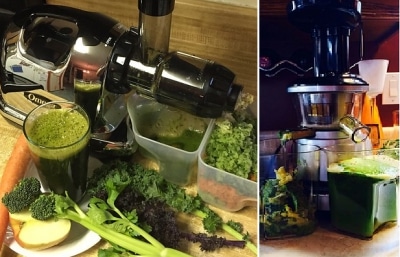If you’ve decided to buy a slow/cold press/masticating juicer over a centrifugal one, the next step is to decide what kind of masticating juicer will best suit your needs. In order to make the right choice, we cover the differences between a vertical vs. horizontal slow juicer based on various factors like produce types, ease of use, how difficult each type is to clean, juice yield, juicing speed and much more.
Cold press juicers in general give you higher quality juice with less wastage because of the way the produce is slowly crushed as opposed to cut in a centrifugal juicer. We explain the benefits of a masticating juicer in more detail separately.
However, there are two types of masticating juicers and in order buy the right slow juicer for your needs so that you’ll make full use of it, you should understand how they differ from each other.
Table of Contents
Comparing a Vertical Vs. Horizontal Slow Juicer
Form of the Machine and its Footprint
Both styles work very similarly in that you feed produce through a chute from the top and a motor runs an augur that crushes the produce and pushes the pulp against a screen. The juice then exits from one end while the pulp is expelled through another.
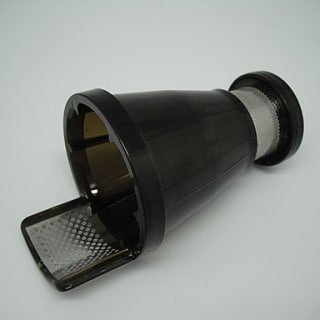
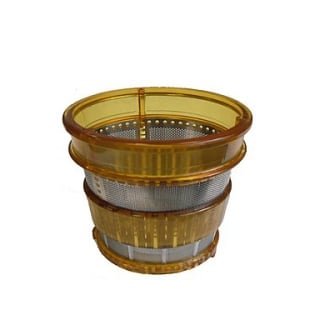
If space is an issue in your kitchen, then you should be aware that a horizontal juicer has a larger footprint and will need more counter space, whereas a vertical one has a much smaller footprint but is also a lot taller. If you choose the latter and you plan to place it on a counter under a kitchen cabinet, make sure that its height can be accommodated.
Ease of Use and Amount of Prep
In general, horizontal juicers are a little easier to assemble, as there are fewer parts involved.
When it comes to operation, you’ll need to push the produce down the feeding chute of a horizontal, so you have to cut up your produce before you start juicing. However, you only have to cut them up enough so that the pieces will fit into the standard width chute. Because you anyway have to push them through, the pieces very rarely jam in there.
Vertical juicers are self-feeding and can come with a standard feed chute OR wide feed chute. There’s a pusher included but you don’t need to use it unless you’re juicing leafy greens that aren’t cut up small. In our experience, a wide chute can deceptively make you think that you don’t have to prep your veggies and fruits to very small pieces. Users can place their produce on the wide mouth tray and let the juicer do the work of pulling everything in. Because the design doesn’t force you to push the pieces in, large pieces may have a tendency to get jammed, especially on hard root vegetables.
However, with a vertical juicer, if you cut your produce into small and manageable pieces, you can prep and feed the juicer in parallel.
So in essence, make a little more effort to prep produce properly for the vertical juicer but possibly do that while the juicer works on your previous batch, or use slightly less effort prepping but spending more time operating the horizontal juicer.
Speed
Want to know the total time it takes to get your juice from either juicer? This includes prep time, juicing time and cleaning time. Along with ease of use, the total time it takes to make juice will determine whether you’ll use your juicer often or just get frustrated and let it sit in a cabinet or in the corner.
The parts of a vertical juicer are kind of stacked on top of each other so you have to line everything up properly while assembling it. This includes the auger, pulp pushing fins, the cleaning blades and the screen. This will take a little bit of extra time.
As explained above, upright slow juicers are self-feeding because as long as the produce doesn’t jam in the chute, the juicer feeds the pieces to the augur without you needing to intervene. Since the filter screen surface area is larger, more pulp can get pressed against it at a time. Many vertical models come with a slightly higher auger RPM to take advantage of this, while still keeping it really low to prevent oxidation and keep more nutrients intact.
A horizontal slow masticating juicer can be assembled very quickly, but after that you need to use the pusher to feed the produce down to the augur. Since the screen here is small, the process is going to be slow.
Types of Produce
For this comparison, let’s divide the types of produce into three categories – soft fruits, root vegetables and hard fruits, and leafy greens.
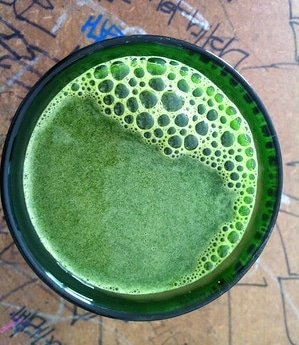
When it comes to root vegetables and dryer fruits like apples, a vertical juicer will jam more easily even if the juice yield is slightly higher, whereas a horizontal cold press has no problem smoothly processing those large hard pieces. As long as it fits through the chute, it will work well. With the former juicer, you can reduce jamming occurrence by cutting up the veggies into smaller pieces.
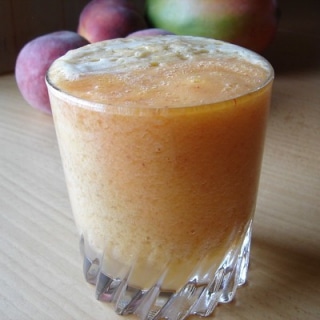
So in summary, a vertical juicer is the winner for soft fruits, while a horizontal juicer is the winner for leafy greens. The latter is a bit better for root vegetables and hard fruits.
Quality of juice extracted and Juice Yield
In the grand scheme of things, this aspect may not be nearly as important when comparing vertical vs. horizontal masticating juicer. Vertical juicers tend to give you a slightly higher yield and clearer juice, especially when juicing soft fruits. However, some high end models come with two strainers so that you can decide how much pulp you want in your juice. A horizontal juicer may give you a little bit more pulp in the glass and will taste slightly heavier. In terms of quality of nutrients, there’s really no difference.
Easy to Clean
When it comes to cleaning there’s a slight winner. Horizontal slow juicers are usually going to be faster to clean on a regular basis because of the way they’re designed. The screen against which the pulp is pressed is small, so very often you may just need to rinse the screen under a tap and do a proper brushing only once every 2-3 juicings. The larger surface area of the screen that needs to be cleaned in a vertical one means it will take at least a few seconds more with the provided cleaning brush.
The other aspect that makes a vertical juicer less easy to clean is the pulp draining channel that runs underneath the juicer. A bit of remnant pulp tends to accumulate there and needs to be manually pushed out – sometimes in the middle of a large juicing job. This channel doesn’t exist in a horizontal type and pulp expulsion is straightforward and non-messy.
However, there’s one thing that new vertical juicers have that horizontals don’t, and that is a juice cap to make cleaning easier. After you’re done with juicing, or in between batches of different types of juice, you can close the juice cap, pour water down the feeding chute, run the machine for a very short amount of time to let the water swirl around in the juice bowl, and then open the juice cap to let the water and remaining pulp drain out.
You may need to rinse the screen out under the tap as well, but if you do this immediately after you finish juicing and before leftover pulp and fiber has a chance to dry, you may not need to do a thorough washing everyday.
So while there’s less chance of leftover pulp remaining inside the horizontal juicer, getting it all out is easier with the vertical one. The former is better if you intend to disassemble the juicer to wash everyday but the latter is better if you only want to do a quick rinse and leave the proper washing for a couple days later.
Versatility
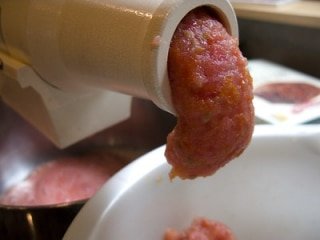
Vertical juicers are not designed to do more than juicing, which they do really well. At the most, a few newer models will come with a sorbet blank, but don’t expect to get amazing results.
Price
Vertical juicers are quite expensive. The technology is newer and there are more parts involved. Horizontal juicers have been around much longer and each part is simple in design, so these juicers are a little more affordable.
Wrap Up
So what type of masticating juicer should you buy? You should now have a clearer idea of the vertical vs. horizontal slow juicer differences.
If you have the counterspace, want to do more than just juicing and want an overall easier experience using it, then get a horizontal slow juicer.
If you only want a machine that takes up less space and does a variety of juicing really well and a little bit faster, then get a vertical cold press juicer.
Once you’ve made your decision, head on over to our picks of the best masticating juicers of each type available to buy.
Featured image adapted from: “Did you know that you are supposed to chew your green drink? Yep. It releases your digestive enzymes. ☀️😊 #nutrition #health #wellness #beproactive #raw #livingfood #omega #juicer #vegetables” by JenTravelsLife
AND
“Juicing it up! My challenge today is to do mini cleanse by having vegetable juice all day. #healthy #fun #fit #fitness #fit4life #gym #muscle #musclebuilder #juicer #omega #green #jose #trainerjose #thankgodimfit #challenge #cleanse” by J@YGS
Omega Horizontal Juicer Filter: Fa. eujuicers
Hurom Vertical Juicer Filter: Fa. eujuicers
Homogenizer screen: “Champion Juicer” by bradley j
Leafy Green Juice: “Green Juice !” by WILLPOWER STUDIOS is licensed under CC BY 2.0
Soft Fruit Juice: “plum & peach juice” by gadl is licensed under CC BY-SA 2.0

